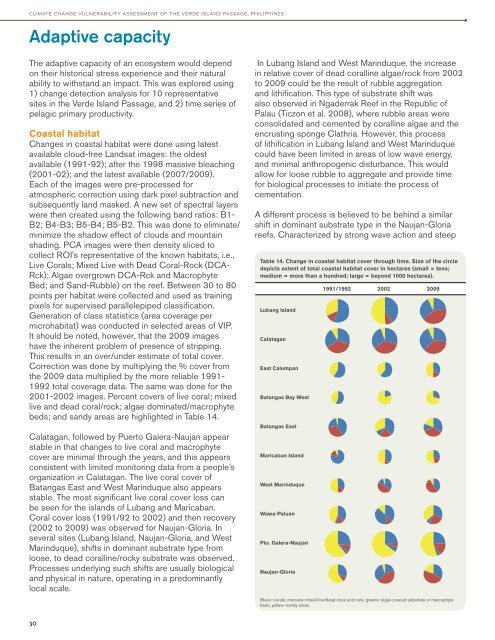of the Verde Island Passage, Philippines - weADAPT
of the Verde Island Passage, Philippines - weADAPT
of the Verde Island Passage, Philippines - weADAPT
Create successful ePaper yourself
Turn your PDF publications into a flip-book with our unique Google optimized e-Paper software.
climate change vulnerability assessment <strong>of</strong> <strong>the</strong> verde island passage, philippines<br />
Adaptive capacity<br />
The adaptive capacity <strong>of</strong> an ecosystem would depend<br />
on <strong>the</strong>ir historical stress experience and <strong>the</strong>ir natural<br />
ability to withstand an impact. This was explored using<br />
1) change detection analysis for 10 representative<br />
sites in <strong>the</strong> <strong>Verde</strong> <strong>Island</strong> <strong>Passage</strong>, and 2) time series <strong>of</strong><br />
pelagic primary productivity.<br />
Coastal habitat<br />
Changes in coastal habitat were done using latest<br />
available cloud-free Landsat images: <strong>the</strong> oldest<br />
available (1991-92); after <strong>the</strong> 1998 massive bleaching<br />
(2001-02); and <strong>the</strong> latest available (2007/2009).<br />
Each <strong>of</strong> <strong>the</strong> images were pre-processed for<br />
atmospheric correction using dark pixel subtraction and<br />
subsequently land masked. A new set <strong>of</strong> spectral layers<br />
were <strong>the</strong>n created using <strong>the</strong> following band ratios: B1-<br />
B2; B4-B3; B5-B4; B5-B2. This was done to eliminate/<br />
minimize <strong>the</strong> shadow effect <strong>of</strong> clouds and mountain<br />
shading. PCA images were <strong>the</strong>n density sliced to<br />
collect ROI's representative <strong>of</strong> <strong>the</strong> known habitats, i.e.,<br />
Live Corals; Mixed Live with Dead Coral-Rock (DCA-<br />
Rck); Algae overgrown DCA-Rck and Macrophyte<br />
Bed; and Sand-Rubble) on <strong>the</strong> reef. Between 30 to 80<br />
points per habitat were collected and used as training<br />
pixels for supervised parallelepiped classification.<br />
Generation <strong>of</strong> class statistics (area coverage per<br />
microhabitat) was conducted in selected areas <strong>of</strong> VIP.<br />
It should be noted, however, that <strong>the</strong> 2009 images<br />
have <strong>the</strong> inherent problem <strong>of</strong> presence <strong>of</strong> stripping.<br />
This results in an over/under estimate <strong>of</strong> total cover.<br />
Correction was done by multiplying <strong>the</strong> % cover from<br />
<strong>the</strong> 2009 data multiplied by <strong>the</strong> more reliable 1991-<br />
1992 total coverage data. The same was done for <strong>the</strong><br />
2001-2002 images. Percent covers <strong>of</strong> live coral; mixed<br />
live and dead coral/rock; algae dominated/macrophyte<br />
beds; and sandy areas are highlighted in Table 14.<br />
Calatagan, followed by Puerto Galera-Naujan appear<br />
stable in that changes to live coral and macrophyte<br />
cover are minimal through <strong>the</strong> years, and this appears<br />
consistent with limited monitoring data from a people’s<br />
organization in Calatagan. The live coral cover <strong>of</strong><br />
Batangas East and West Marinduque also appears<br />
stable. The most significant live coral cover loss can<br />
be seen for <strong>the</strong> islands <strong>of</strong> Lubang and Maricaban.<br />
Coral cover loss (1991/92 to 2002) and <strong>the</strong>n recovery<br />
(2002 to 2009) was observed for Naujan-Gloria. In<br />
several sites (Lubang <strong>Island</strong>, Naujan-Gloria, and West<br />
Marinduque), shifts in dominant substrate type from<br />
loose, to dead coralline/rocky substrate was observed.<br />
Processes underlying such shifts are usually biological<br />
and physical in nature, operating in a predominantly<br />
local scale.<br />
In Lubang <strong>Island</strong> and West Marinduque, <strong>the</strong> increase<br />
in relative cover <strong>of</strong> dead coralline algae/rock from 2002<br />
to 2009 could be <strong>the</strong> result <strong>of</strong> rubble aggregation<br />
and lithification. This type <strong>of</strong> substrate shift was<br />
also observed in Ngaderrak Reef in <strong>the</strong> Republic <strong>of</strong><br />
Palau (Ticzon et al. 2008), where rubble areas were<br />
consolidated and cemented by coralline algae and <strong>the</strong><br />
encrusting sponge Clathria. However, this process<br />
<strong>of</strong> lithification in Lubang <strong>Island</strong> and West Marinduque<br />
could have been limited in areas <strong>of</strong> low wave energy,<br />
and minimal anthropogenic disturbance. This would<br />
allow for loose rubble to aggregate and provide time<br />
for biological processes to initiate <strong>the</strong> process <strong>of</strong><br />
cementation.<br />
A different process is believed to be behind a similar<br />
shift in dominant substrate type in <strong>the</strong> Naujan-Gloria<br />
reefs. Characterized by strong wave action and steep<br />
Table 14. Change in coastal habitat cover through time. Size <strong>of</strong> <strong>the</strong> circle<br />
depicts extent <strong>of</strong> total coastal habitat cover in hectares (small = tens;<br />
medium = more than a hundred; large = beyond 1000 hectares).<br />
Lubang <strong>Island</strong><br />
Calatagan<br />
East Calumpan<br />
Batangas Bay West<br />
Batangas East<br />
Maricaban <strong>Island</strong><br />
West Marinduque<br />
Wawa-Paluan<br />
Pto. Galera-Naujan<br />
Naujan-Gloria<br />
1991/1992 2002 2009<br />
Blues–corals, maroons–mixed live/dead coral and rock, greens–algal covered substrate or macrophyte<br />
beds, yellow–sandy areas.<br />
30
















